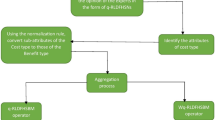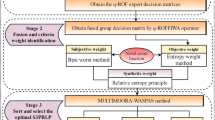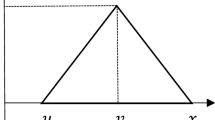Abstract
The idea of the circular economy (CE) has gained prominence in the policies of the European Union (EU), commerce, and academic studies. Basically, CE is capable of achieving the best value and resolving many of the systemic challenges in the society and commerce of a country, thus leading to sustainable development and preventing irreparable damage to the environment. Medical waste management has proved a daunting challenge with the increase in the global population and the demand for medical services. Fuzzy multi-criteria decision-making approaches try to cover the different and uncertain views of decision-makers (DMs). The present study suggests a novel strategy based on multi-objective optimization using the ratio analysis (MOORA) in the area of spherical fuzzy sets (SFSs) to counterbalance the disadvantages of the failure modes and effects analysis (FMEA) method, such as the lack of weight assignment for risk factors and consideration of uncertainty. In the proposed method, first, the barriers are identified using the FMEA method, and the risk factors are given values. Then, the barriers identified using MOORA are prioritized in the spherical fuzzy (SF) area. The computational procedure of the proposed methodology is established through a case study of the barriers to circular economy implementation in designing sustainable medical waste management systems problems under an SF environment. The proposed approach was compared with IF-MOORA and was found that the results are more reliable using the proposed method, also the ranking in the MOORA method was compared with the TOPSIS method in terms of degree of correlation.



Similar content being viewed by others
Data availability
Not applicable.
References
Akbari R et al (2020) HSE risk prioritization of molybdenum operation process using extended FMEA approach based on Fuzzy BWM and Z-WASPAS. J Intell Fuzzy Syst 38(4):5157–5173
Atanassov KT (1989) More on intuitionistic fuzzy sets. Fuzzy Sets Syst 33(1):37–45
Attri R, Grover S (2014) Decision making over the production system life cycle: MOORA method. Int J Syst Assur Eng Manag 5(3):320–328
Babayara Y et al (2013) Poor Medical Waste Management (MWM) practices and its risks to human health and the environment: a literature review. Int J Environ Ealth Sci Eng 11(7):1–8
Baležentis A et al (2012) Personnel selection based on computing with words and fuzzy MULTIMOORA. Expert Syst Appl 39(9):7961–7967
Bevilacqua M, Braglia M (2000) The analytic hierarchy process applied to maintenance strategy selection. Reliab Eng Syst Saf 70(1):71–83
Bowles JB, Peláez CE (1995) Fuzzy logic prioritization of failures in a system failure mode, effects and criticality analysis. Reliab Eng Syst Saf 50(2):203–213
Braglia M et al (2003) Fuzzy criticality assessment model for failure modes and effects analysis. Int J Qual Reliab Manag 20:503–524
Brauers WK, Zavadskas EK (2006) The MOORA method and its application to privatization in a transition economy. Control Cybern 35:445–469
Brauers WK, Zavadskas EK (2009) Robustness of the multi-objective MOORA method with a test for the facilities sector. Technol Econ Dev Econ 15(2):352–375
Brauers WKM, Zavadskas EK (2012) Robustness of MULTIMOORA: a method for multi-objective optimization. Informatica 23(1):1–25
Bruel A et al (2019) Linking industrial ecology and ecological economics: A theoretical and empirical foundation for the circular economy. J Ind Ecol 23(1):12–21
Carnero MC (2020) Waste segregation FMEA model integrating intuitionistic fuzzy set and the PAPRIKA method. Mathematics 8(8):1375
Chand M et al (2018) ANP-MOORA-based approach for the analysis of selected issues of green supply chain management. Benchmark: Int J 25:642–659
Chang K-H (2009) Evaluate the orderings of risk for failure problems using a more general RPN methodology. Microelectron Reliab 49(12):1586–1596
Chang K-H, Cheng C-H (2010) A risk assessment methodology using intuitionistic fuzzy set in FMEA. Int J Syst Sci 41(12):1457–1471
de Aguiar J et al (2018) Using fuzzy logic to reduce risk uncertainty in failure modes and effects analysis. J Braz Soc Mech Sci Eng 40(11):1–15
Dorosti S et al (2020) Patient waiting time management through fuzzy based failure mode and effect analysis. J Intell Fuzzy Syst 38:2069–2080
Ghisellini P, Cialani C, Ulgiati S (2016) A review on circular economy: the expected transition to a balanced interplay of environmental and economic systems. J Clean Prod 114:11–32
Ghoushchi SJ et al (2019) An extended FMEA approach based on the Z-MOORA and fuzzy BWM for prioritization of failures. Appl Soft Comput 81:105505
Ghoushchi SJ et al (2020) Qualitative and quantitative analysis of waste management literature from 2000 to 2015. Int J Environ Waste Manage 26(4):471–486
Ghoushchi SJ et al (2021a) Extended approach by using best–worst method on the basis of importance–necessity concept and its application. Appl Intell 51:8030–8044
Ghoushchi SJ, Bonab SR, Ghiaci AM, Haseli G, Tomaskova H, Hajiaghaei-Keshteli M (2021b) Landfill Site Selection for Medical Waste Using an Integrated SWARA-WASPAS Framework Based on Spherical Fuzzy Set. Sustainability 13(24):13950
Ghoushchi SJ et al (2021c) An extended approach to predict retinopathy in diabetic patients using the genetic algorithm and fuzzy C-means. BioMed Res Int 2021:1–13
Goyal S et al (2021) Analyzing critical success factors to adopt sustainable consumption and production linked with circular economy. Environ Dev Sustain 23:1–30
Gündoğdu FK, Kahraman C (2020a) A novel spherical fuzzy analytic hierarchy process and its renewable energy application. Soft Comput 24(6):4607–4621
Gündoğdu FK, Kahraman C (2020b) A novel spherical fuzzy QFD method and its application to the linear delta robot technology development. Eng Appl Artif Intell 87:103348
Gündoğdu FK et al (2019) Spherical fuzzy VIKOR method and its application to waste management. International Conference on Intelligent and Fuzzy Systems, Springer, Berlin
Ilbahar E et al (2018) A novel approach to risk assessment for occupational health and safety using Pythagorean fuzzy AHP & fuzzy inference system. Saf Sci 103:124–136
Jafarzadeh Ghoushchi S et al (2019) Multi-criteria sustainable supplier selection using piecewise linear value function and fuzzy best-worst method. J Intell Fuzzy Syst 37(2):2309–2325
Jafarzadeh Ghoushchi S et al (2020) Integrated decision-making approach based on SWARA and GRA methods for the prioritization of failures in solar panel systems under Z-information. Symmetry 12(2):310
Jafarzadeh-Ghoushchi S, Dorosti S (2017) Effects of exposure to a variety of waste on human health-a review. J Liaquat Univ Medic Health Sci 16(1):3–9
Jun H, Xiang H (2011) Development of circular economy is a fundamental way to achieve agriculture sustainable development in China. Energy Proc 5:1530–1534
Kane G et al (2018) Towards design strategies for circular medical products. Resour Conserv Recycl 135:38–47
Karande P, Chakraborty S (2012) Application of multi-objective optimization on the basis of ratio analysis (MOORA) method for materials selection. Mater Des 37:317–324
Kutlu Gündoğdu F, Kahraman C (2019) A novel VIKOR method using spherical fuzzy sets and its application to warehouse site selection. J Intell Fuzzy Syst 37(1):1197–1211
Leslie H, Leonards P, Brandsma S, De Boer J, Jonkers N (2016) Propelling plastics into the circular economy—weeding out the toxics first. Environ Int 94:230–234
Liu H-C et al (2013) Risk evaluation approaches in failure mode and effects analysis: A literature review. Expert Syst Appl 40(2):828–838
Mangla SK et al (2018) Benchmarking the risk assessment in green supply chain using fuzzy approach to FMEA: insights from an Indian case study. Benchmark: Int J 25:2660–2687
Mathew M et al (2020) A novel approach integrating AHP and TOPSIS under spherical fuzzy sets for advanced manufacturing system selection. Eng Appl Artif Intell 96:103988
Mavi RK et al (2017) Sustainable third-party reverse logistic provider selection with fuzzy SWARA and fuzzy MOORA in plastic industry. Int J Adv Manuf Technol 91(5):2401–2418
Moorhouse D, Moorhouse D (2017) Sustainable design: circular economy in fashion and textiles. Des J 20(sup1):S1948–S1959
Moreau V et al (2017) Coming full circle: why social and institutional dimensions matter for the circular economy. J Ind Ecol 21(3):497–506
Morlet A, Opsomer R, Herrmann S, Balmond L, Gillet C, Fuchs L (2017) A new textiles economy: redesigning fashion’s future. Ellen MacArthur Foundation, Cowes
Neufeld L, Stassen F, Sheppard R, Gilman T (2016) The new plastics economy: rethinking the future of plastics. World Economic Forum, Cologny
Ouyang L, Zhu Y, Zheng W, Yan L (2021) An information fusion FMEA method to assess the risk of healthcare waste. J Manag Sci Eng 6(1):111–124
Parida V, Burström T, Visnjic I, Wincent J (2019) Orchestrating industrial ecosystem in circular economy: A two-stage transformation model for large manufacturing companies. J Bus Res 101:715–725
Patel JD, Maniya KD (2015) Application of AHP/MOORA method to select wire cut electrical discharge machining process parameter to cut EN31 alloys steel with brasswire. Mater Today: Proc 2(4–5):2496–2503
Pillay A, Wang J (2003) Modified failure mode and effects analysis using approximate reasoning. Reliab Eng Syst Saf 79(1):69–85
Puente J et al (2002) A decision support system for applying failure mode and effects analysis. Int J Qual Reliab Manag 19:137–150
Qin J et al (2020) Failure mode and effects analysis (FMEA) for risk assessment based on interval type-2 fuzzy evidential reasoning method. Appl Soft Comput 89:106134
Ranjbarzadeh R, Saadi SB (2020) Automated liver and tumor segmentation based on concave and convex points using fuzzy c-means and mean shift clustering. Measurement 150:107086
Ranjbarzadeh R et al (2020) LNPSS: SAR image despeckling based on local and non-local features using patch shape selection and edges linking. Measurement 164:107989
Ranjbarzadeh R et al (2021) Lung infection segmentation for COVID-19 Pneumonia based on a cascade convolutional network from CT images. BioMed Res Int 2021:1–16
Renjith V et al (2018) Fuzzy FMECA (failure mode effect and criticality analysis) of LNG storage facility. J Loss Prev Process Ind 56:537–547
Rezaee MJ, Salimi A, Yousefi S (2017) Identifying and managing failures in stone processing industry using cost-based FMEA. Int J Adv Manuf Technol 88(9–12):3329–3342
Rezaee MJ, Yousefi S, Eshkevari M, Valipour M, Saberi M (2020) Risk analysis of health, safety and environment in chemical industry integrating linguistic FMEA, fuzzy inference system and fuzzy DEA. Stoch Env Res Risk Assess 34(1):201–218
Shihab S et al (2018) Application of MOORA method for multi optimization of GMAW process parameters in stain-less steel cladding. Manag Sci Lett 8(4):241–246
Singh N et al (2021) Medical waste: current challenges and future opportunities for sustainable management. Crit Rev Environ Sci Technol 2021:1–23
Sobral J, Teixeira D, Morais H, Neves M (2017) Methodology to assess medical processes based on a Failure Mode and Effects Analysis (FMEA). 2017 IEEE 5th Portuguese Meeting on Bioengineering (ENBENG), Coimbra
Tavana M et al (2020) An integrated fuzzy framework for analyzing barriers to the implementation of continuous improvement in manufacturing. Int J Qual Reliab Manag 38:116–146
Tirkolaee EB et al (2018) A robust periodic capacitated arc routing problem for urban waste collection considering drivers and crew’s working time. Waste Manage 76:138–146
Wan C et al (2019) An advanced fuzzy Bayesian-based FMEA approach for assessing maritime supply chain risks. Transp Res Part e Logis Transp Rev 125:222–240
Winans K et al (2017) The history and current applications of the circular economy concept. Renew Sustain Energy Rev 68:825–833
Yousefi S, Alizadeh A, Hayati J, Baghery M (2018) HSE risk prioritization using robust DEA-FMEA approach with undesirable outputs: a study of automotive parts industry in Iran. Saf Sci 102:144–158
Zamparas M et al (2019) Medical waste management and environmental assessment in the Rio University Hospital Western Greece. Sustain Chem Pharm 13:100163
Author information
Authors and Affiliations
Contributions
Saeid Jafarzadeh Ghoushchi: conceptualization, investigation, validation, writing—reviewing, and editing. Ali Memarpour Ghiaci: conceptualization, investigation, and methodology. Shabnam Rahnamay Bonab: formal analysis, investigation, and validation. Ramin Ranjbarzadeh: conceptualization, writing—reviewing and editing, and validation. All authors read and approved the final manuscript.
Corresponding author
Ethics declarations
Ethics approval
Not applicable.
Consent to participate
Not applicable.
Consent for publication
Not applicable.
Competing interests
The authors declare that they have no competing interests.
Additional information
Responsible Editor: Philippe Garrigues.
Publisher's Note
Springer Nature remains neutral with regard to jurisdictional claims in published maps and institutional affiliations.
Rights and permissions
About this article
Cite this article
Jafarzadeh Ghoushchi, S., Memarpour Ghiaci, A., Rahnamay Bonab, S. et al. Barriers to circular economy implementation in designing of sustainable medical waste management systems using a new extended decision-making and FMEA models. Environ Sci Pollut Res 29, 79735–79753 (2022). https://doi.org/10.1007/s11356-022-19018-z
Received:
Accepted:
Published:
Issue Date:
DOI: https://doi.org/10.1007/s11356-022-19018-z




